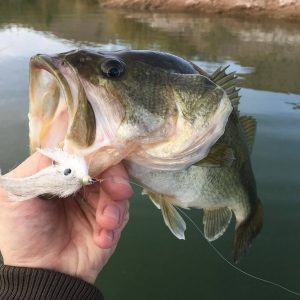By Cal Kellogg
Picture the scene, your deer hair mouse lands delicately along the edge of the tules. You begin twitching the fly forward. Suddenly the water bulges, the tules shutter and you see the sleek green largemouth as it rushes the fly.
 The rod snaps upward drawing into a graceful arc as the bass surges out of the water with the hair mouse pinned to its lip…
The rod snaps upward drawing into a graceful arc as the bass surges out of the water with the hair mouse pinned to its lip…
Are you ready for the thrill and challenge of fly rod bass fishing?Fly fishing has the undeserved reputation as being a complicated and expensive endeavor, yet there are rod reel and line combos for under $70 that will do the job nicely. That’s less than you expect to pay for a comfortable bait casting or spinning rig.
Fly rods are rated by line weight. The smaller the line weight the more delicate the rig. For bass, you’ll want to stick with a 7 or 8 weight rod that is 9 feet in length.
Once you’ve settled on a rod, reel and line the next step is buying a commercial tapered leader or two in weights that are heavy enough for bass fishing.
The heavy section attaches to the fly line while the fly attaches to the light end. The taper is critical since this is what caused the leader to lay out straight. The light end of my bass leaders are typically 12 to 15-pound test.
Hardcore fly anglers utilize sinking lines to probe depths to 20 and beyond. The casual enthusiast should stick with floating line to target bass from the surface to 8 feet deep or so.
For shallow water fishing, there are three basic types of flies, surface bugs, divers, and streamers. The most effective surface bugs are made out of deer hair to resemble mice or frogs and should be worked accordingly.
A diver is minnow shaped with a deer hair head and a long feather body. These flies are worked like a floating minnow plug. At rest, they set on the surface. When retrieved with a series of tugs and pauses they dive and display a rise and drop action that predators can’t resist.
Streamers are sinking flies constructed of feathers and fur. These flies are tied to imitate baitfish. Think of streamers as suspending crankbaits. 
After casting the streamer, allow it to sink to the desired depth and then work it along with an erratic strip and pause retrieve.
The biggest adjustment you’ll have to make when switching from conventional tackle to fly gear is the means of retrieving line. With conventional gear the reel is used to move the lure through the water.
To work a fly, run the line between the index and middle fingers of the rod hand and retrieve line by striping it in with your free hand. When you hook a fish the fingers on the rod hand act as your drag. When the fish runs release line. When the bass weakens keep the line tight by stripping line in.
The classic places for using flies are cover choked waters, but don’t hesitate using them in rocky open water reservoirs. I’ve had some memorable days targeting Folsom’s acrobatic spots and smallmouths with yellow divers worked over rocky structure.
